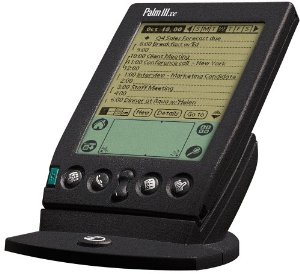Why I want my Palm business card beaming back


As someone who works in sales, I find myself going to a lot of in-person networking events. It's great to be able to get out of the office and meet people, and exchange contact information for follow-ups.
What I've been noticing increasingly, however, is that everyone seems to have gone back to handing out paper business cards, because it's much more convenient to do this than to type out even a quick introductory email to someone using your smartphone or tablet at a gathering.
I personally have not carried printed business cards in over five years. I had them last made out when I joined IBM in 2007, and when I switched jobs within that company and moved to Florida from New Jersey I never had them re-issued.
When I joined Microsoft in December of 2012 I didn't have them made up either. Now that I think about it, I probably should.
But there has to be a better way of exchanging contact information. Business cards get lost, and the information on them has to be either manually entered into the contacts manager app on your device or scanned in somehow, which requires OCR technology and is subject to all the problems that are associated with that.
Emailing contact information is better, but then the contact info ends up in an email thread and not necessarily entered into your address book unless a virtual card file (.vcf) is enclosed. And of course you have to manually click on that .vcf to import it into your contacts manager.
It should come as a surprise to some of you that there was a better way of dealing with this problem, and it was solved 17 years ago, with the introduction of the Palm III PDA.
The Palm III was the first of a series of hand-held devices made by Palm and its OEM licensees (yes, it had several, Google was not the first to do this with Android) that could "Beam" all of your relevant contact information to another Palm-compatible device as long as it had the required IR-beaming and receiving hardware.
All you had to do was hold down the hardware contacts button, point it at another Palm unit, and within 3 seconds, they had all your information. It was a simple technology, and it worked pretty much flawlessly.
Of course, this primarily only worked on Palms, but back then, Palm had something along the line of 90 percent market share in the PDA market. Windows CE also had PDAs, and there were apps that allowed those devices to receive data and beam to Palms. I don't recall exactly if Psion/Symbian had a similar way of dealing with the cross-OS beaming problem but I'm pretty sure it did. I know even the Apple Newton could do it.
The modern smartphone eschewed the IrDA blaster in favor of "better" technology in the form of Bluetooth, cellular data and Wi-Fi, but we don't have an easy solution for ad-hoc contacts sync.
Yes, there's the new AirDrop in iOS 7, but it doesn't work as easily as one would hope it would, and it's also not cross-platform with Android or Windows Phone. And Android Beam requires NFC, and only works with other Androids with NFC. Wi-Fi Direct, while potentially a good cross-platform solution, has not gotten widespread industry buy-in.
So how could we get that cool feature back, and ensure it works on all devices? Well, I have some ideas.
First, we start with the good 'ol QR code. Every person would claim a registered QR code which would essentially contain the URL to a website or a web service that publishes XML that contains the contact information you wanted to share. This could include not just email and snail mail addresses, titles and companies and phone numbers, but also links to preferred social media accounts and profiles on Twitter and LinkedIn.
Potentially, I see LinkedIn, Google, Microsoft and Apple running their own QR code registries, or even the usual domain registrar subjects. And you should be able to transfer that registered QR home to whoever can host that kind of service at any time.
You should also be able to edit the contents of that published XML at any time, so if you changed jobs, or changed phone numbers, or what have you, that data could be automatically refreshed in everyone's devices provided the PIM software in those devices supported dynamic refresh. However your registered QR code and the feed address would always stay the same, like a email address or a phone number.
Next, we build applications for the mobile devices that allow quick display of that QR code on the device screen, and would also permit the forward-facing camera on each device to capture the QR code on the -other- device, so you have your "handshake" as it were.
Of course, you could always print out these QR codes as fashionable buttons and pin them to your jackets, et cetera. If we actually start using wearable computers, this is the sort of thing most people will want.
Geeky? Sure. But short of us going back to IrDA or figuring out how to get everyone to adopt Wi-Fi Direct, we need a solution like this.
Were you a Palm "Beamer?" Talk Back and Let Me Know.